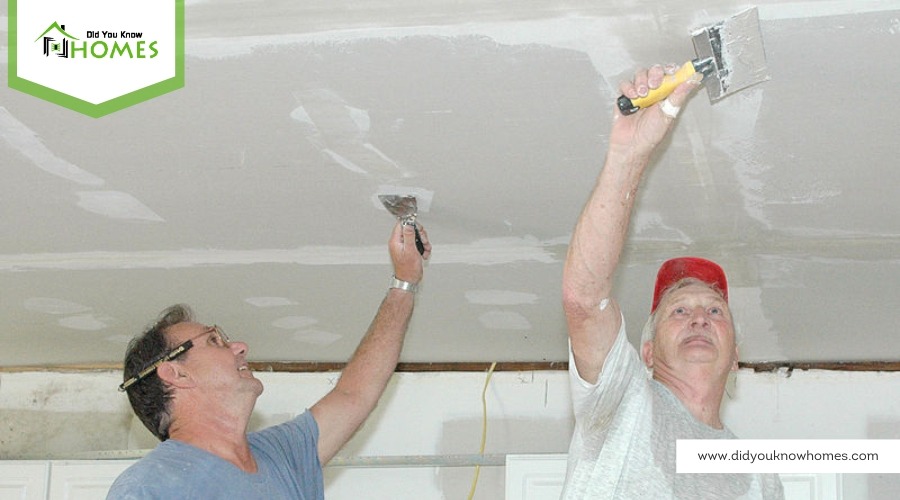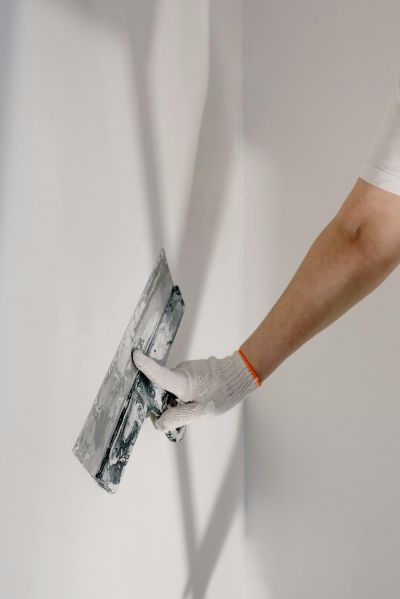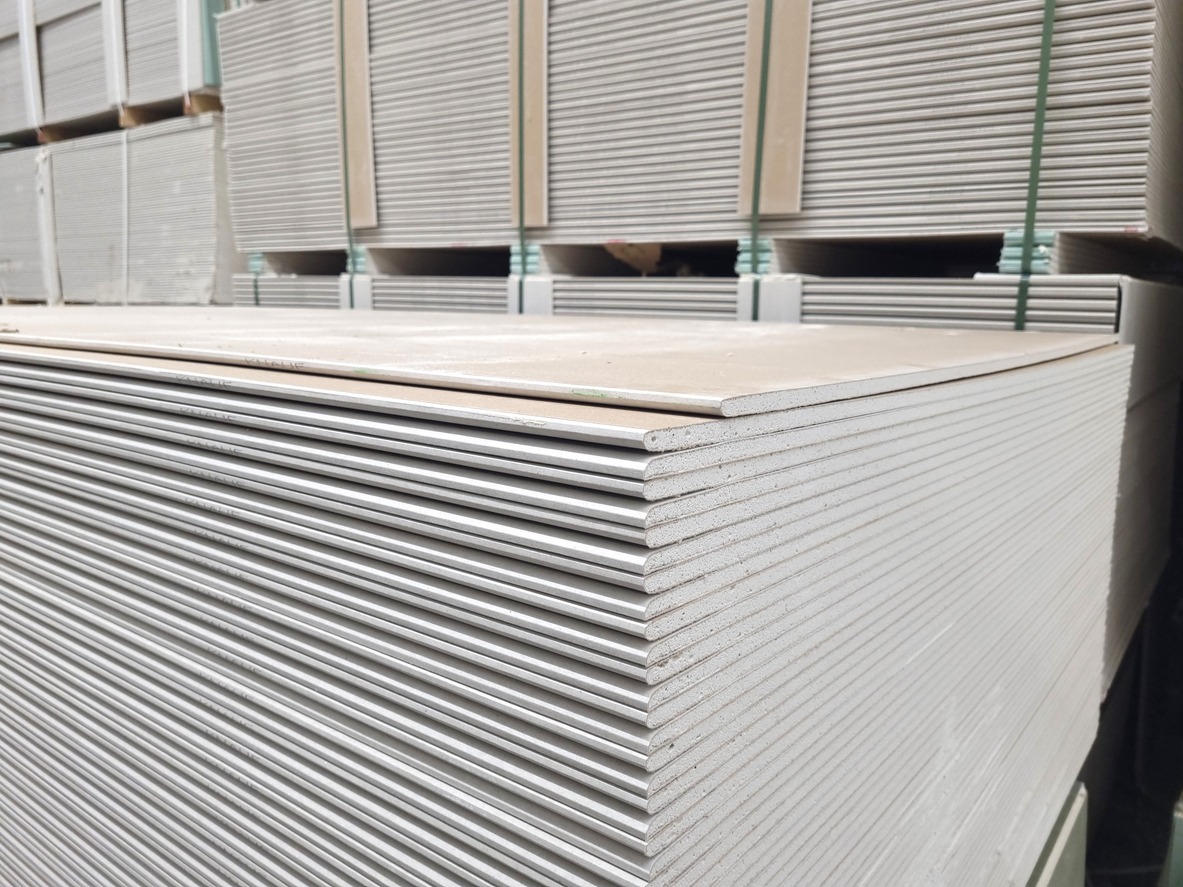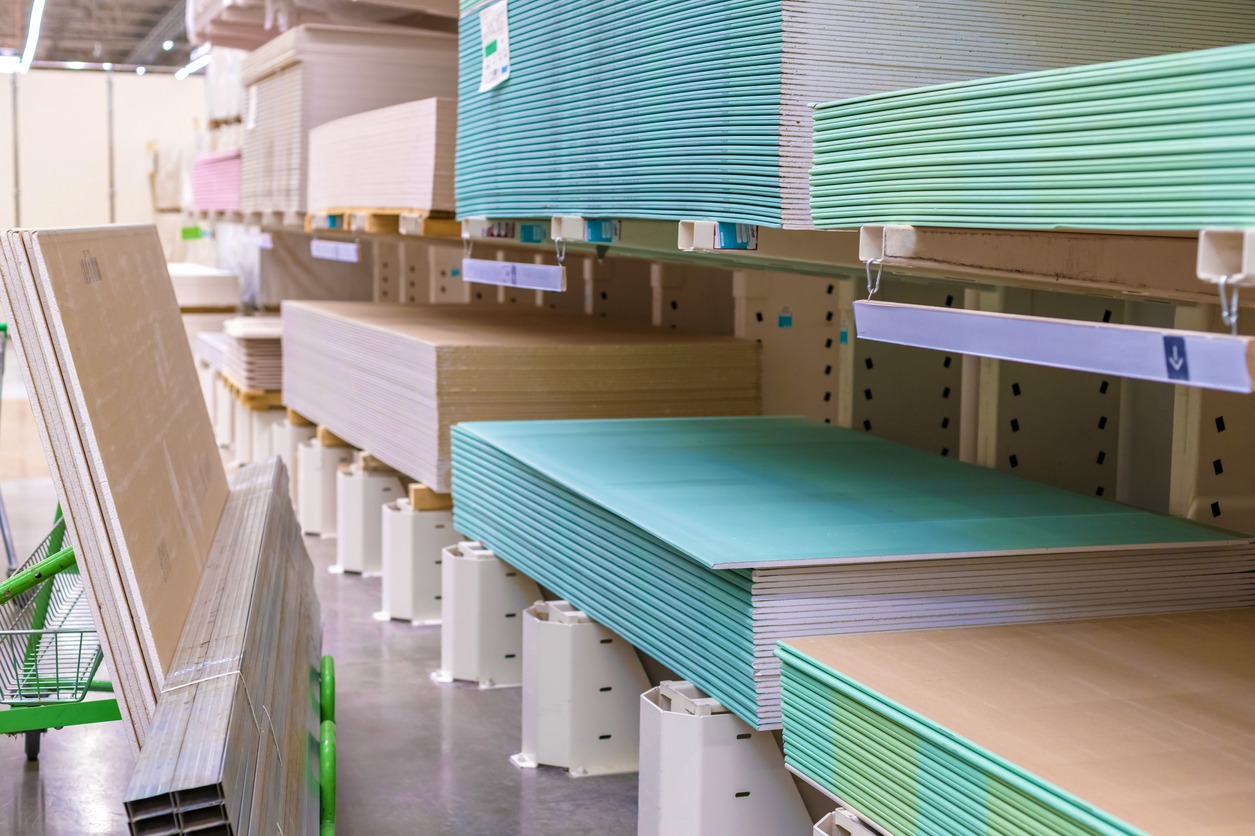You might think the history of drywall is a dry topic, but there’s more intrigue and innovation behind those walls than you’d expect. Since its inception in 1916, drywall, or sheetrock, revolutionized the construction industry, offering a fireproof, quick, and economical alternative to traditional plaster. Its journey from a novel invention to a global proof in construction is a validation to human ingenuity and adaptability. As we peel back the layers, you’ll discover the wartime shifts, manufacturing advancements, and the challenges overcome to make drywall the versatile, soundproof, and cost-effective material we rely on today. The story behind the walls that surround us is surprisingly compelling.
Plaster Beginnings
Plaster, with its origins tracing back to ancient Egypt, has been a fundamental building material long before the invention of drywall. You’ve probably marveled at the smooth finishes of ancient structures without realizing that what you’re admiring is the handiwork of plaster. This versatile material’s history is as rich as the civilizations that first used it. The Egyptians, for instance, incorporated plaster in the construction of the iconic pyramids, seamlessly blending functionality with an aesthetic appeal.
Moving forward in time, the Greeks and Romans extensively utilized plaster not just in buildings but also in sculptures, showcasing its versatility. The real game-changer, however, came when French chemist Antoine Lavoisier analyzed gypsum. His groundbreaking work led to the development of Plaster of Paris, a key component that revolutionized the construction industry. This advancement made plaster even more indispensable in construction, cementing its place in the creation of major structures and monuments.
Today, plaster’s historical significance is undeniable. Its widespread use in ancient structures and its continued presence in high-end construction projects underscore its enduring appeal. You’re witnessing centuries of architectural history and innovation whenever you see a plastered wall, a demonstration of the enduring legacy of this ancient material.
Gypsum Board Revolution
As you explore the transformation of construction materials, you’ll find that the gypsum board was a pivotal innovation. Starting with the Sackett Board in 1894 and evolving into today’s Sheetrock, this journey showcases significant technological advancements. The global adoption trends, peaking in 2020 with 8.4 billion square meters sold, underscore the material’s universal appeal and efficiency.
Early Gypsum Board Use
Marking a pivotal turn in construction materials, the invention of Sackett Board in 1894 initiated the gypsum board revolution. This innovation laid the groundwork for what you now recognize as drywall, fundamentally changing both residential and commercial construction. When the United States Gypsum Corporation introduced Sheetrock in 1917, it wasn’t just another product—it revolutionized the industry, making the use of drywall ubiquitous.
Here are key points about early gypsum boards:
- They’re made by enclosing gypsum plaster between layers of paper.
- The production process uses natural gas in drying chambers.
- FGD gypsum is utilized, showcasing sustainability efforts.
- By 2020, the global sales of drywall hit 8.4 billion square meters, underscoring its widespread adoption.
Technological Advancements
Building on the solid foundation established by early gypsum board innovations, the gypsum board revolution was propelled forward by significant technological advancements. The Sackett Plaster Board Company’s invention in 1894 was a game-changer, laying the groundwork for future developments. Then, Sheetrock, introduced by the US Gypsum Corporation in 1917, further revolutionized the industry, enhancing construction efficiency with its unique composition. Drywall, made of gypsum plaster sandwiched between two paper layers, became synonymous with rapid, reliable building methods. The manufacturing process evolved, incorporating natural gas in drying chambers and utilizing FGD gypsum, boosting energy efficiency. By 2020, the global demand for this versatile material reached 8.4 billion square meters, a reflection of its widespread adoption and the impact of these technological advancements.
Global Adoption Trends
Drywall’s global journey, specifically Sheetrock’s widespread adoption since its introduction in 1917 by the US Gypsum Corporation, has profoundly shaped the construction industry worldwide. This revolution isn’t just about the numbers; it’s also about versatility and innovation in both commercial and residential construction.
Consider these key aspects of global adoption:
- Approximately 8.4 billion square meters of drywall sold globally in 2020.
- Adaptations like Gyprock and Gyproc cater to specific regional needs.
- Variations in thickness, length, and width for diverse construction requirements.
- Special edge treatments reflecting regional preferences.
These points underscore drywall panels’ adaptability and widespread acceptance in the construction industry, highlighting their significant role in shaping modern construction practices across the globe.
The Rise of Sheetrock
As you explore the history of construction materials, you’ll find that the invention of Sheetrock in 1917 by the US Gypsum Corporation marked a pivotal moment. Its quick market expansion and advantages over traditional plaster, such as cost-effectiveness and fire resistance, set new standards in the industry. These benefits not only streamlined the building process but also led to its widespread adoption in both residential and commercial projects.
Invention of Sheetrock
In 1917, the US Gypsum Corporation introduced Sheetrock, revolutionizing the construction industry with its efficient, cost-effective, and fire-resistant properties. The invention of Sheetrock marked a pivotal shift from traditional plaster, transforming how buildings were constructed. This revolutionary building material quickly became popular for several reasons:
- Efficiency: Markedly accelerated the building process.
- Cost-effectiveness: Provided a more budget-friendly alternative to plaster.
- Fire Resistance: Improved safety in construction.
- Ease of Installation: Streamlined the construction process.
With these advantages, Sheetrock changed the landscape of the construction industry. Its introduction was not just about a new material; it was about reimagining building practices, making the construction of homes and buildings faster, safer, and more economical than ever before.
Sheetrock’s Market Expansion
Following World War II, Sheetrock’s market demand soared, marking its widespread adoption in both residential and commercial construction projects. The United States Gypsum Corporation, the genius behind Sheetrock since 1917, witnessed its product revolutionize the construction industry. Thanks to its ease of installation, Sheetrock became a go-to material for builders, greatly reducing construction times. This post-World War II era saw Sheetrock’s market expansion as it cemented its place in the construction of modern America. Its versatility allowed for custom shapes and designs, making it indispensable for a wide range of architectural needs. Today, Sheetrock’s dominance in the market continues, with options designed to meet specific needs, such as fire resistance and soundproofing, ensuring its place in construction projects across the nation.
Advantages Over Traditional Plaster
Building on its post-World War II success, Sheetrock offered several key advantages over traditional plaster that greatly influenced its rise in the construction industry. This innovative material not only revolutionized how homes were built but also introduced a more practical approach to interior finishes.
Consider these notable benefits:
- Fire Resistance: Sheetrock’s composition made it inherently more resistant to fire, enhancing building safety.
- Cost-Effective: It profoundly reduced the overall expenses involved in wall construction.
- Efficient Production: The ability to mass-produce Sheetrock streamlined supply chains.
- Ease of Installation: With Sheetrock, construction times were drastically shortened, completing homes ten times faster than with traditional plaster methods.
These advantages made Sheetrock a cornerstone in the shift towards more efficient, safer, and cost-effective building practices in the construction industry.
Wartime Construction Shifts
During wartime, the construction industry experienced a significant shift towards using drywall due to its quick and efficient installation process, requiring fewer laborers. In the United States, especially around the World War periods, the need for rapid construction projects was paramount. The urgency of wartime demanded swift solutions for infrastructure, making drywall the go-to option for its efficiency and ease of transport and installation.
The ease with which drywall could be transported and installed made it a preferred choice for wartime construction projects. It allowed for the rapid construction of homes and buildings, important for meeting the urgent demand for infrastructure. This shift wasn’t just about practicality; using drywall was also seen as a patriotic choice, supporting mass construction efforts and rebuilding initiatives essential during these challenging times.
The wartime period underscored the advantages of drywall, highlighting its benefits in terms of speed, efficiency, and cost-effectiveness. This period of history marked a turning point, showcasing drywall’s potential to revolutionize construction practices, not just during times of conflict but in peacetime development as well. The industry’s pivot towards drywall during these years laid the groundwork for its widespread adoption and the eventual dominance we see today.
Advancements in Manufacturing
As the use of drywall became more prevalent in construction, significant advancements in manufacturing processes played a key role in its evolution. These improvements have not only enhanced the quality of drywall but also its sustainability and the overall environmental impact of its production.
The heart of these advancements lies in several key areas:
- Refined Manufacturing Techniques: Modern drywall manufacturing has seen a leap in efficiency and precision. The automation of drying chambers and the integration of computerized systems guarantee consistent quality and faster production times.
- Sustainability Practices: The adoption of FGD gypsum, a byproduct from the process of reducing sulfur dioxide emissions from power plants, as a primary raw material, marks a significant step toward greener production methods.
- Reduced Environmental Impact: Innovations in manufacturing have led to reduced energy consumption, especially with the use of natural gas in drying chambers, minimizing the carbon footprint of drywall production.
- Quality Improvement: Continuous improvements in the formulation and the manufacturing process have resulted in drywall that is more durable, easier to install, and better performing regarding fire resistance and insulation.
These advancements in manufacturing techniques underscore a commitment to quality, sustainability, and reducing environmental impact, ensuring that drywall remains a preferred choice in construction.
Global Adoption and Variations
Drywall, known by various names around the world, has become an essential component in modern construction, widely adopted for its versatility and ease of installation. The history of drywall reveals its rapid ascent as a preferred construction material, particularly in the United States, where it’s found in about 90% of homes. But it’s not just an American favorite. In Australia and New Zealand, it’s referred to as plasterboard or gib board and is equally prevalent.
As you explore the global adoption of drywall, you’ll find that Canada has tailored its use with specific panel sizes and thicknesses to meet the demands of both residential and commercial projects. Across the Atlantic, Europe presents a variety of types of drywall, with brands like Knauf and British Gypsum leading the way in innovation and installation techniques.
Despite the differences in names, specifications, and brands, the core function of drywall remains unchanged. It’s a proof to the material’s fundamental role in construction projects worldwide. Whether you’re building a home in the United States or a commercial space in Europe, drywall is a go-to solution for walls and ceilings, thanks to its history of adaptability and global adoption.
Challenges and Solutions
Facing challenges like water damage and pest infestation, the drywall industry has developed innovative solutions to guarantee durability and safety. You’ve seen how water exposure can lead to mold growth, making areas like your bathroom a hotspot for these issues. But, with the introduction of Greenboard, the industry’s tackled this head-on, offering you a mold-resistant option that keeps those damp spaces in your home safer and cleaner.
Termite damage, a less thought about but equally destructive force, has also been a focal point. The drywall sector’s response? More robust materials that deter these pests, safeguarding your home’s integrity. And it’s not just about the physical damage. Safety concerns stemming from honeybees to defective Chinese drywall emitting harmful sulfur compounds have pushed the industry towards tighter quality control and the need for thorough pest control measures.
To emphasize the multifaceted approach the industry has taken, consider these key solutions:
- Introduction of Greenboard for mold resistance
- Development of termite-resistant drywall materials
- Implementation of strict quality control measures
- Adoption of thorough pest control strategies
These steps make certain that your home doesn’t just stay standing but remains a safe, healthy environment for you and your family.
Fire Resistance Innovations
In the quest for safer homes and buildings, the drywall industry has made significant strides in fire resistance, introducing innovations like Type X drywall and Sheetrock Firecode Core panels. These advancements are more than just technical achievements; they’re a proof of the industry’s commitment to your safety and peace of mind. Type X drywall, for instance, is designed to withstand fire exposure for longer periods, becoming a staple in areas where safety cannot be compromised.
| Innovation | Emotional Impact |
|---|---|
| Type X Drywall | Instills confidence in the structural integrity of your home during a fire. |
| Sheetrock Firecode Core | Offers peace of mind knowing your space meets stringent fire safety codes. |
| Fireguard Panels | Assures a safer environment, reducing stress in fire-prone situations. |
Furthermore, Firecode C panels and Fireguard panels have pushed the envelope further, incorporating special additives and engineered solutions to enhance fire safety in both commercial and residential buildings. These innovations don’t just meet the minimum safety standards; they exceed them, ensuring that your space isn’t just a building, but a fortress against the threat of fire.
The Modern Era of Drywall
As the 20th century progressed, Sheetrock, also known as drywall, fundamentally transformed the construction industry with its efficiency and cost-effectiveness. This shift marked the beginning of the modern era for construction projects, where speed, affordability, and versatility became key. Sheetrock’s quick installation process compared to traditional plaster meant that buildings could rise faster, enabling a construction boom post-World War II that reshaped cities and suburbs.
In the modern era, drywall’s benefits are even more pronounced, thanks to advancements in production techniques and the introduction of variations tailored to specific needs. Here are four key points that highlight its importance:
- Quick Installation: Drywall’s easy and fast installation process accelerates the completion of construction projects.
- Cost-Effectiveness: It remains an affordable option, ensuring projects stay within budget.
- Versatility: Modern drywall comes in various types for different applications, making it a versatile building material.
- Standard Material: Sheetrock has become the go-to for walls and ceilings, a sign of its widespread acceptance and reliability.
As a versatile and efficient building material, Sheetrock continues to play a vital role in shaping the modern urban landscape, underlining its standing as an essential part of construction projects globally.
Conclusion
In sum, you’ve seen how drywall transformed from its plaster beginnings to a global staple in construction. Its journey, marked by the gypsum board revolution and wartime shifts, led to significant advancements and widespread adoption. Despite challenges, innovations in fire resistance and manufacturing have solidified its place in modern construction. Drywall’s cost-effectiveness, versatility, and efficiency make sure it remains a favored choice. You’re now part of a legacy that continues to shape the built world around us.






